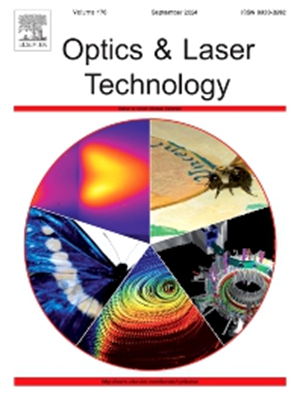An efficient on-site calibration method and precise measurement model for miniaturized rotational parts based on four-axis linkage spatial measurement system
IF 4.6
2区 物理与天体物理
Q1 OPTICS
引用次数: 0
Abstract
The key geometric parameters of miniaturized rotational parts significantly influence the overall performance and service life of equipment, such as bore diameter, roundness, cylindricity, generatrix contour, etc. However, most existing measurement technologies are aimed at certain types of parameters and fail to provide full-scale and high-precision measurements, especially when measuring space is limited. In this paper, a 4-axis linkage spatial measurement system is established, equipped with a precision air-floating turntable and a compact fiber optic probe. Innovations include: (1) An efficient 4-axis linkage calibration method is proposed. This method can achieve precise calibration of the laser direction vector or the rotation axis position with only a single scan; (2) On this basis, a polar-coordinate measurement model for any positive section of rotational parts is proposed, eliminating the negative impact of part offset on measurement accuracy. Experimental results show that the measurement error of the diameter, the roundness and the cylindricity is approximately , and , respectively. The average measurement error of the generatrix contour is . Compared with the traditional contact coordinate measuring machine, the overall measurement efficiency is improved by about 67%, demonstrating that this method meets the requirements for on-site efficient and precise measurement of miniaturized rotational parts.

基于四轴联动空间测量系统的小型旋转部件高效现场标定方法和精确测量模型
小型化转动件的关键几何参数,如内径、圆度、圆柱度、母线轮廓等,对设备的整体性能和使用寿命有重要影响。然而,现有的大多数测量技术都是针对某些类型的参数,无法提供全尺寸和高精度的测量,特别是在测量空间有限的情况下。本文采用精密气浮转台和紧凑型光纤探头,建立了四轴联动空间测量系统。创新点包括:(1)提出了一种高效的四轴联动标定方法。该方法只需一次扫描即可实现激光方向矢量或旋转轴位置的精确标定;(2)在此基础上,提出了旋转零件任意正截面极坐标测量模型,消除了零件偏置对测量精度的负面影响。实验结果表明,该方法的直径、圆度和圆柱度测量误差分别约为3μm、2μm和2.8μm。母线轮廓的平均测量误差为4μm。与传统接触坐标测量机相比,整体测量效率提高了约67%,表明该方法满足了小型旋转部件现场高效、精确测量的要求。
本文章由计算机程序翻译,如有差异,请以英文原文为准。
求助全文
约1分钟内获得全文
求助全文
来源期刊
CiteScore
8.50
自引率
10.00%
发文量
1060
审稿时长
3.4 months
期刊介绍:
Optics & Laser Technology aims to provide a vehicle for the publication of a broad range of high quality research and review papers in those fields of scientific and engineering research appertaining to the development and application of the technology of optics and lasers. Papers describing original work in these areas are submitted to rigorous refereeing prior to acceptance for publication.
The scope of Optics & Laser Technology encompasses, but is not restricted to, the following areas:
•development in all types of lasers
•developments in optoelectronic devices and photonics
•developments in new photonics and optical concepts
•developments in conventional optics, optical instruments and components
•techniques of optical metrology, including interferometry and optical fibre sensors
•LIDAR and other non-contact optical measurement techniques, including optical methods in heat and fluid flow
•applications of lasers to materials processing, optical NDT display (including holography) and optical communication
•research and development in the field of laser safety including studies of hazards resulting from the applications of lasers (laser safety, hazards of laser fume)
•developments in optical computing and optical information processing
•developments in new optical materials
•developments in new optical characterization methods and techniques
•developments in quantum optics
•developments in light assisted micro and nanofabrication methods and techniques
•developments in nanophotonics and biophotonics
•developments in imaging processing and systems

 求助内容:
求助内容: 应助结果提醒方式:
应助结果提醒方式:


